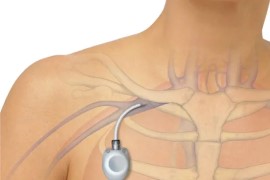Chemoport Insertion
Chemotherapy port insertion, also known as chemoport insertion or portacath insertion, is a surgical procedure performed to provide a long-term access point for delivering chemotherapy medications or other intravenous treatments directly into a patient's bloodstream. It is commonly used in patients who require repeated or prolonged courses of chemotherapy or other intravenous therapies.
During the procedure, a small chamber called a port is implanted under the skin, usually in the chest area. The port consists of two main components: a small reservoir or chamber and a thin, flexible tube called a catheter. The catheter is inserted into a large vein, typically the jugular vein in the neck or the subclavian vein in the chest, and it is threaded until the tip reaches a major vein near the heart.
The port is usually made of a durable material such as titanium or plastic to minimize the risk of infection and ensure long-term use. The port chamber has a silicone self-sealing membrane that can be accessed using a special needle, allowing healthcare providers to administer medications or draw blood samples without the need for repeated needle sticks.
Chemoport insertion is typically performed under local anesthesia or conscious sedation. The surgeon makes a small incision to create a pocket for the port chamber, and then the catheter is inserted into the vein and connected to the chamber. The incision is closed with sutures or adhesive strips, and a sterile dressing is applied.
What are the common symptoms of Chemoport Insertion?
The common symptoms or side effects associated with chemoport insertion are typically related to the procedure itself and the presence of the port. Here are some potential symptoms that can occur after chemoport insertion:
- Soreness or discomfort
- Swelling or bruising
- Redness or tenderness
- Scarring or visible port
- Discomfort during port use
- Infection
Types of Chemoport Insertion?
There are several types of chemoport insertion techniques commonly used. The specific technique chosen may depend on factors such as the patient's anatomy, medical condition, and the preference of the healthcare provider. Here are three common types of chemoport insertion:
- Percutaneous Subclavian Insertion: This is the most frequently used technique for chemoport insertion. It involves creating a small incision in the skin near the collarbone and placing the port through a subclavian vein (located beneath the collarbone). The catheter attached to the port is then threaded into the vein, allowing for easy access for chemotherapy administration.
- Percutaneous Jugular Insertion: In this technique, the port is inserted through a small incision in the neck and into the internal jugular vein, which is located in the neck region. The catheter is then advanced through the vein and connected to the port. This approach may be used if subclavian vein access is difficult or contraindicated.
- Totally Implantable Port Insertion: This technique involves placing the port entirely under the skin, usually in the upper chest or upper arm region. The port is then connected to a catheter that is threaded into a major blood vessel, such as the subclavian or jugular vein. The port can be accessed by healthcare professionals using a special needle through the skin to administer chemotherapy.
How to prepare for Chemoport Insertion?
- Consult with your healthcare provider: Discuss the need for a chemoport and the procedure details with your healthcare provider. They will explain the benefits, risks, and expected outcomes of chemoport insertion based on your specific medical condition.
- Review medical history and medications: Provide your healthcare team with a comprehensive medical history, including any underlying medical conditions, allergies, or previous surgeries. Inform them about all medications, including over-the-counter drugs, herbal supplements, and vitamins, as some may need to be adjusted prior to the procedure.
- Pre-procedure instructions: Your healthcare provider will provide specific instructions to prepare for chemoport insertion. Follow these instructions carefully, which may include guidelines on fasting before the procedure and any medications that need to be stopped or continued.
- Arrange transportation and support: Chemoport insertion is usually performed on an outpatient basis, but it is advisable to arrange transportation to and from the hospital or clinic. Additionally, consider having a friend or family member accompany you for support during the procedure.
- Wear comfortable clothing: Choose loose-fitting, comfortable clothing that allows easy access to the upper chest or neck area. This will make it easier for the healthcare provider to position you during the procedure.
- Follow pre-procedure dietary restrictions: If instructed by your healthcare provider, follow any dietary restrictions or fasting guidelines before the procedure. This may involve avoiding food or drink for a certain period of time prior to the chemoport insertion.
- Communicate with the healthcare team: If you have any concerns or questions leading up to the procedure, don't hesitate to reach out to your healthcare team. They can provide clarification, address any anxieties, and offer guidance based on your individual needs.
- Arrange for post-procedure care: After the chemoport insertion, you may require some time to recover and rest. Make sure you have a plan in place for post-procedure care, including any necessary time off work or assistance with daily activities, if needed.
Best Doctor for Chemotherapy in Ahmedabad
Dr. Manthan Merja (Patel)
MBBS, MS (Gen. Surgery) - B. J. Medical College.
MCh-Surgical Oncologist - GCRI, BJMC.
- FIOP (ESSO Europe)
- FARIS (Robotic Surgery)
- FALS (Robotic Surgery)
Dr. Manthan Merja is a consultant surgical oncologist in Ahmedabad. He is a qualified
oncologist with over 10 years of experience in the field. He is an expert in the
treatment of all types of cancer, including breast cancer, lung cancer, colorectal
cancer, and gastric cancer.
Dr. Merja completed his MBBS from BJ Medical College, Ahmedabad in 2012. He then went on
to complete his MS in General Surgery from the same college in 2015. In 2019, he
completed his MCh in Surgical Oncology from Gujarat Cancer & Research Institute.
FAQ About Chemoport Insertion
-
What is a chemoport?A chemoport, also known as a port-a-cath or port, is a small medical device implanted under the skin that provides easy access to a vein for administering chemotherapy drugs or other medications. It consists of a port, which is a small reservoir, and a catheter that connects the port to a large vein.
-
Why is a chemoport inserted?Chemoports are inserted to facilitate the administration of chemotherapy drugs or other medications. They provide a more reliable and convenient access point for medication delivery compared to repeated needle sticks in a vein. Chemoports can also be used for blood draws and other necessary procedures.
-
How is a chemoport inserted?Chemoport insertion is typically performed in an operating room or interventional radiology suite. It involves making a small incision in the skin, creating a pocket under the skin for the port, and tunneling the catheter into a large vein. The procedure is usually done under local anesthesia or sedation.


